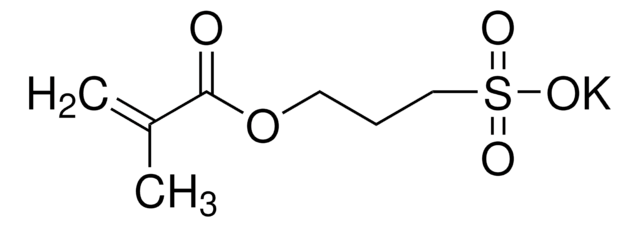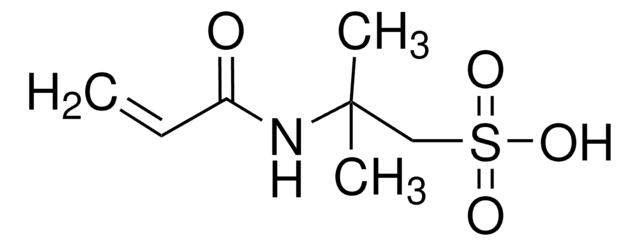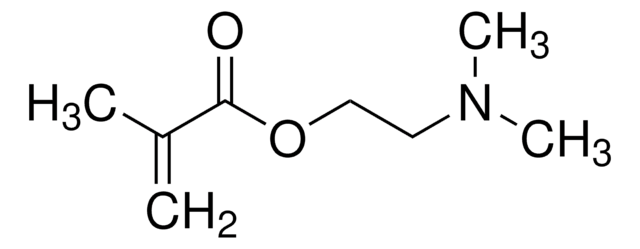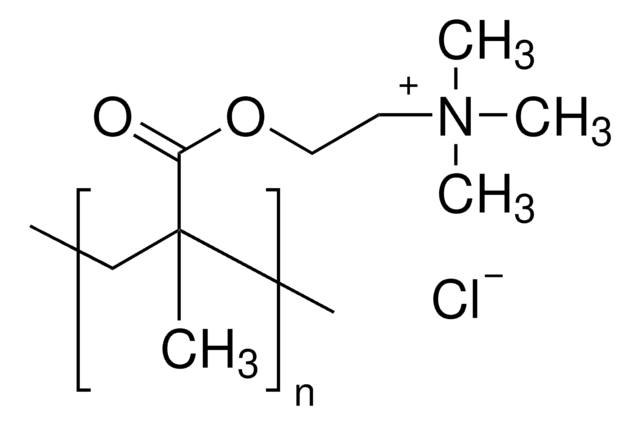496146
[2-(Acryloyloxy)ethyl]trimethylammonium chloride solution
80 wt. % in H2O, contains 600 ppm monomethyl ether hydroquinone as inhibitor
Synonym(s):
2-(Dimethylamino)ethyl acrylate, methyl chloride quaternary salt
Sign Into View Organizational & Contract Pricing
All Photos(1)
About This Item
Linear Formula:
H2C=CHCO2CH2CH2N(CH3)3Cl
CAS Number:
Molecular Weight:
193.67
MDL number:
UNSPSC Code:
12162002
PubChem Substance ID:
NACRES:
NA.23
Recommended Products
contains
600 ppm monomethyl ether hydroquinone as inhibitor
Quality Level
concentration
80 wt. % in H2O
refractive index
n20/D 1.478
density
1.132 g/mL at 25 °C
storage temp.
2-8°C
SMILES string
[Cl-].C[N+](C)(C)CCOC(=O)C=C
InChI
1S/C8H16NO2.ClH/c1-5-8(10)11-7-6-9(2,3)4;/h5H,1,6-7H2,2-4H3;1H/q+1;/p-1
InChI key
FZGFBJMPSHGTRQ-UHFFFAOYSA-M
Application
- Dual functional quaternary chitosans with thermoresponsive behavior: structure-activity relationships in antibacterial activity and biocompatibility: This research evaluates quaternary chitosans modified with [2-(Acryloyloxy)ethyl]trimethylammonium chloride, analyzing their thermoresponsive properties, antibacterial activity, and biocompatibility, which are critical for developing smart biomaterials (Borandeh et al., 2023).
- Removal of Antimony(III) and Antimony(V) from water samples through water-soluble polymer-enhanced ultrafiltration: The application of [2-(Acryloyloxy)ethyl]trimethylammonium chloride in environmental science is illustrated by its use in enhancing polymer ultrafiltration systems designed for the efficient removal of antimony contaminants from water (Dündar et al., 2022).
- Stable Antimicrobial Activity Achieved via Immobilization of Quaternary Ammonium Chloride on Hair: This article explores the immobilization of [2-(Acryloyloxy)ethyl]trimethylammonium chloride on hair fibers, achieving stable antimicrobial properties which are proposed for use in hygienic hair care products (Kim and Son, 2018).
Signal Word
Warning
Hazard Statements
Precautionary Statements
Hazard Classifications
Acute Tox. 4 Oral - Eye Irrit. 2 - Skin Sens. 1
Storage Class Code
12 - Non Combustible Liquids
WGK
WGK 1
Flash Point(F)
Not applicable
Flash Point(C)
Not applicable
Choose from one of the most recent versions:
Already Own This Product?
Find documentation for the products that you have recently purchased in the Document Library.
MingDong Wang et al.
ACS applied materials & interfaces, 8(35), 23289-23301 (2016-08-16)
We demonstrate for the first time how to assemble mechanized hollow zirconia nanospheres (MHzNs), consisting of hollow mesoporous zirconia nanospheres (HMZNs) as nanoscaffolds and supramolecular switches anchored on the exterior surface of HMZNs. The remarkable advantage of substitution of HMZNs
Ursula Simon et al.
Journal of chromatography. A, 1587, 119-128 (2018-12-24)
Monolithic adsorbers with anion exchange (AEX) properties have been 3D printed in an easy one-step process, i.e. not requiring post-functionalization to introduce the AEX ligands. The adsorber, 3D printed using a commercial digital light processing (DLP) printer, was obtained by
Kecen Xiao et al.
Journal of biomedical materials research. Part A, 107(10), 2205-2221 (2019-05-23)
The mechanical and biodegradable properties of hydrogels are two essential properties for practical biomaterial applications. In this work, a series of biodegradable polyurethane (PU) hydrogels were successfully synthesized using two kinds of triol crosslinkers with different chain structures. One crosslinker
Cristina Cagnetta et al.
Bioresource technology, 291, 121833-121833 (2019-07-30)
High-rate activated sludge (HRAS) systems typically generate diluted sludge which requires further thickening prior to anaerobic digestion (AD), besides the need to add considerable coagulant and flocculant for the solids separation. As an alternative to conventional gravitational settling, a dissolved
Wenquan Sun et al.
Journal of environmental sciences (China), 99, 239-248 (2020-11-14)
In this study, a high-efficiency cationic flocculant, P(DAC-MAPTAC-AM), was successfully prepared using UV-induced polymerization technology. The monomer Acrylamide (AM): Acryloxyethyl Trimethyl ammonium chloride (DAC): methacrylamido propyl trimethyl ammonium chloride (MAPTAC) ratio, monomer concentration, photoinitiator concentration, urea content, and cationic monomer
Our team of scientists has experience in all areas of research including Life Science, Material Science, Chemical Synthesis, Chromatography, Analytical and many others.
Contact Technical Service![[2-(Methacryloyloxy)ethyl]trimethylammonium chloride solution 75 wt. % in H2O](/deepweb/assets/sigmaaldrich/product/structures/316/612/66b0f4cf-d060-427d-b4f5-e8fab3e5cffe/640/66b0f4cf-d060-427d-b4f5-e8fab3e5cffe.png)

![[2-(Methacryloyloxy)ethyl]dimethyl-(3-sulfopropyl)ammonium hydroxide 95%](/deepweb/assets/sigmaaldrich/product/structures/217/219/73c91e1c-0ee4-4b3d-bead-a6dc3d09d1da/640/73c91e1c-0ee4-4b3d-bead-a6dc3d09d1da.png)
![[3-(Methacryloylamino)propyl]trimethylammonium chloride solution 50 wt. % in H2O](/deepweb/assets/sigmaaldrich/product/structures/189/736/089bc8ae-2a98-416d-9f9a-a0a510b6b828/640/089bc8ae-2a98-416d-9f9a-a0a510b6b828.png)






